Exploring Drug Mechanisms and Monitoring in Pharmacology
VerifiedAdded on 2023/06/15
|7
|1629
|496
Homework Assignment
AI Summary
This assignment provides detailed answers to pharmacology questions, focusing on the mechanisms of action and monitoring requirements for various drugs, including vincristine, paracetamol, contraceptive pills, ventolin, risperidone, captopril, amoxycillin, dantrolene, vitamin K, and cortisol. Each drug's mechanism is explained, detailing how it interacts with the body to produce its therapeutic effects. The assignment also outlines the essential monitoring parameters for each drug to assess its efficacy, detect potential side effects, and ensure patient safety. Monitoring includes physical examinations, blood tests, and specific assessments related to each drug's target system, such as liver function tests for paracetamol and blood pressure monitoring for captopril. The overall aim is to provide a comprehensive understanding of how these drugs work and how their effects are carefully managed in clinical practice. Desklib offers a wealth of similar solved assignments and study resources to support students in their academic pursuits.
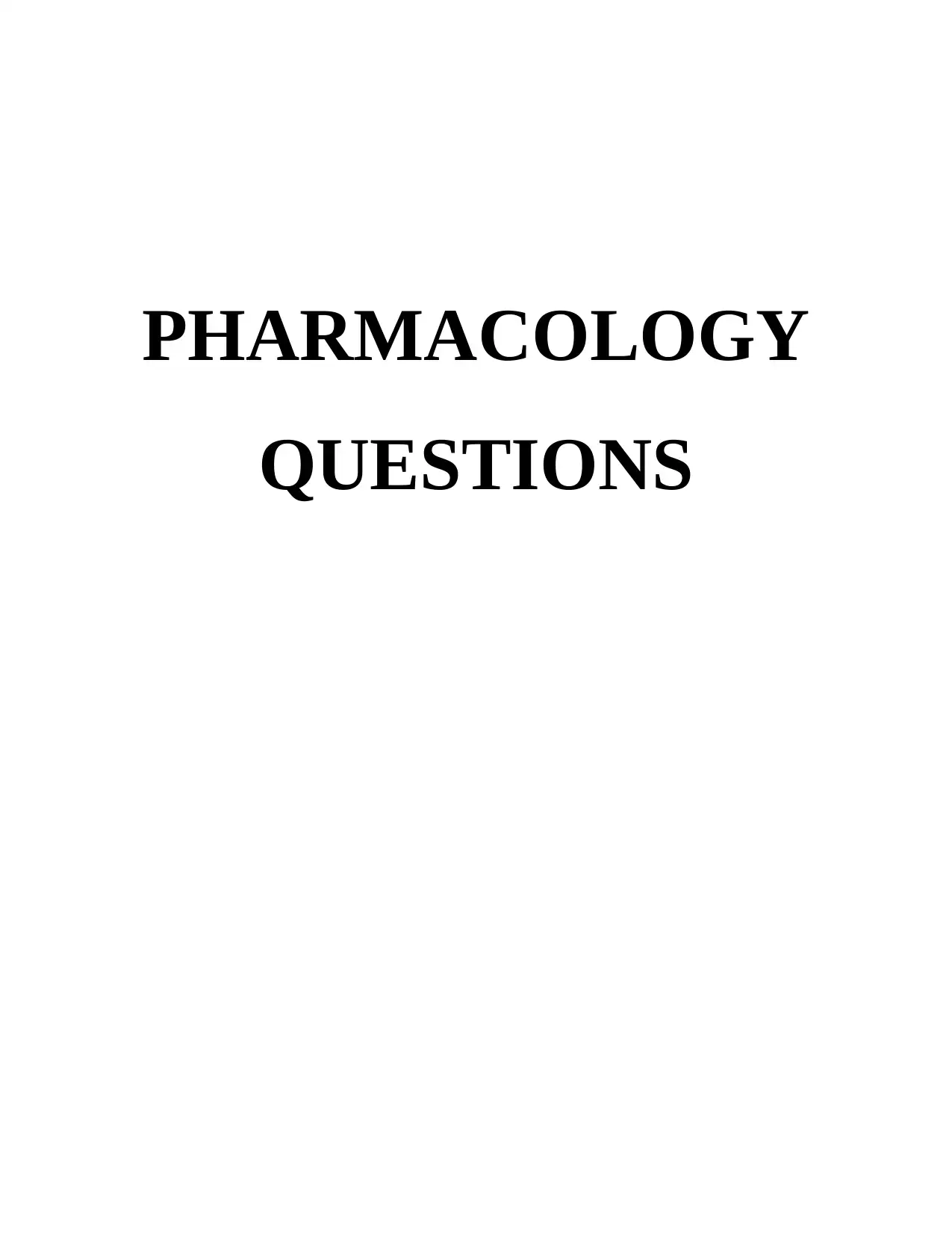
PHARMACOLOGY
QUESTIONS
QUESTIONS
Paraphrase This Document
Need a fresh take? Get an instant paraphrase of this document with our AI Paraphraser
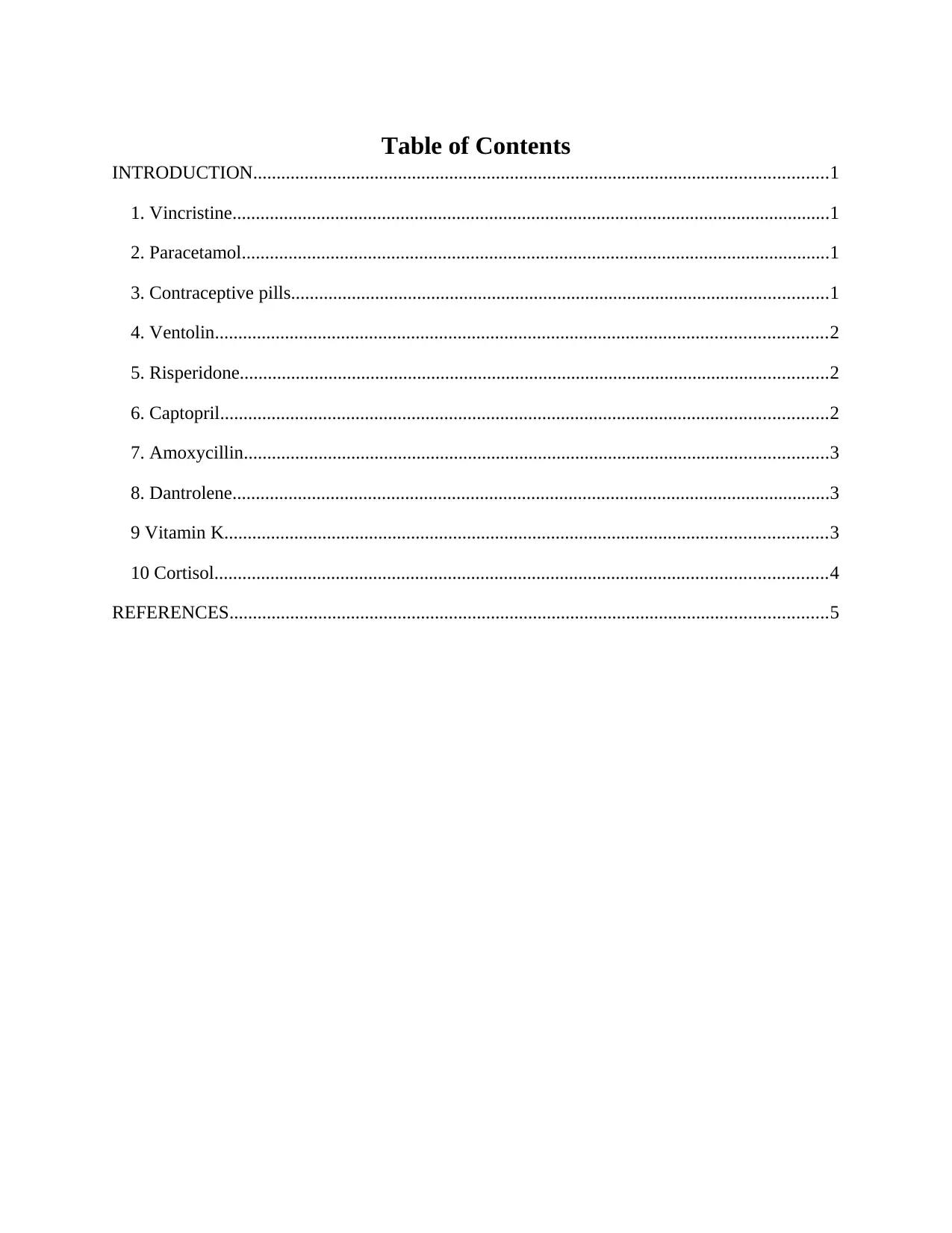
Table of Contents
INTRODUCTION...........................................................................................................................1
1. Vincristine................................................................................................................................1
2. Paracetamol..............................................................................................................................1
3. Contraceptive pills...................................................................................................................1
4. Ventolin...................................................................................................................................2
5. Risperidone..............................................................................................................................2
6. Captopril..................................................................................................................................2
7. Amoxycillin.............................................................................................................................3
8. Dantrolene................................................................................................................................3
9 Vitamin K.................................................................................................................................3
10 Cortisol...................................................................................................................................4
REFERENCES................................................................................................................................5
INTRODUCTION...........................................................................................................................1
1. Vincristine................................................................................................................................1
2. Paracetamol..............................................................................................................................1
3. Contraceptive pills...................................................................................................................1
4. Ventolin...................................................................................................................................2
5. Risperidone..............................................................................................................................2
6. Captopril..................................................................................................................................2
7. Amoxycillin.............................................................................................................................3
8. Dantrolene................................................................................................................................3
9 Vitamin K.................................................................................................................................3
10 Cortisol...................................................................................................................................4
REFERENCES................................................................................................................................5
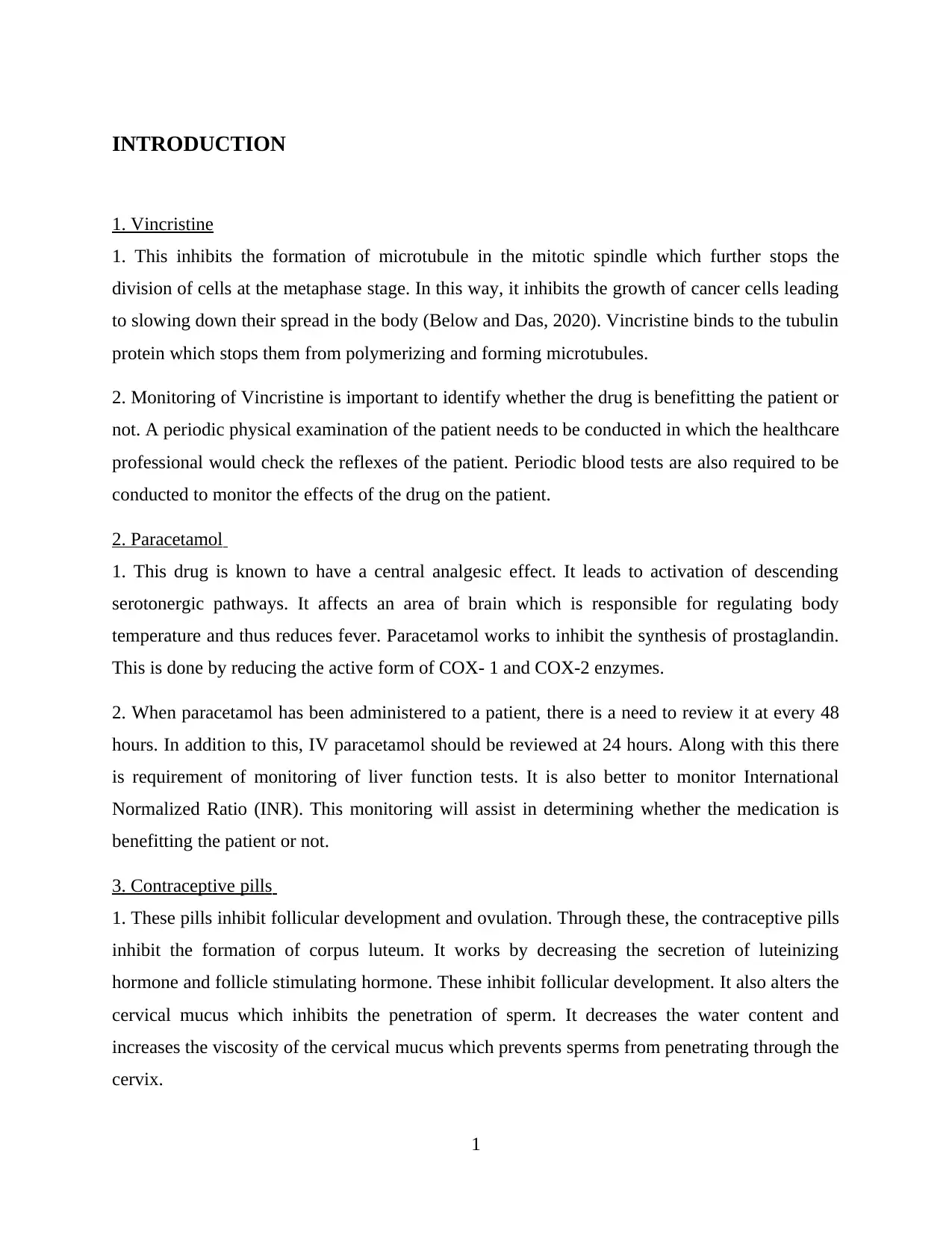
INTRODUCTION
1. Vincristine
1. This inhibits the formation of microtubule in the mitotic spindle which further stops the
division of cells at the metaphase stage. In this way, it inhibits the growth of cancer cells leading
to slowing down their spread in the body (Below and Das, 2020). Vincristine binds to the tubulin
protein which stops them from polymerizing and forming microtubules.
2. Monitoring of Vincristine is important to identify whether the drug is benefitting the patient or
not. A periodic physical examination of the patient needs to be conducted in which the healthcare
professional would check the reflexes of the patient. Periodic blood tests are also required to be
conducted to monitor the effects of the drug on the patient.
2. Paracetamol
1. This drug is known to have a central analgesic effect. It leads to activation of descending
serotonergic pathways. It affects an area of brain which is responsible for regulating body
temperature and thus reduces fever. Paracetamol works to inhibit the synthesis of prostaglandin.
This is done by reducing the active form of COX- 1 and COX-2 enzymes.
2. When paracetamol has been administered to a patient, there is a need to review it at every 48
hours. In addition to this, IV paracetamol should be reviewed at 24 hours. Along with this there
is requirement of monitoring of liver function tests. It is also better to monitor International
Normalized Ratio (INR). This monitoring will assist in determining whether the medication is
benefitting the patient or not.
3. Contraceptive pills
1. These pills inhibit follicular development and ovulation. Through these, the contraceptive pills
inhibit the formation of corpus luteum. It works by decreasing the secretion of luteinizing
hormone and follicle stimulating hormone. These inhibit follicular development. It also alters the
cervical mucus which inhibits the penetration of sperm. It decreases the water content and
increases the viscosity of the cervical mucus which prevents sperms from penetrating through the
cervix.
1
1. Vincristine
1. This inhibits the formation of microtubule in the mitotic spindle which further stops the
division of cells at the metaphase stage. In this way, it inhibits the growth of cancer cells leading
to slowing down their spread in the body (Below and Das, 2020). Vincristine binds to the tubulin
protein which stops them from polymerizing and forming microtubules.
2. Monitoring of Vincristine is important to identify whether the drug is benefitting the patient or
not. A periodic physical examination of the patient needs to be conducted in which the healthcare
professional would check the reflexes of the patient. Periodic blood tests are also required to be
conducted to monitor the effects of the drug on the patient.
2. Paracetamol
1. This drug is known to have a central analgesic effect. It leads to activation of descending
serotonergic pathways. It affects an area of brain which is responsible for regulating body
temperature and thus reduces fever. Paracetamol works to inhibit the synthesis of prostaglandin.
This is done by reducing the active form of COX- 1 and COX-2 enzymes.
2. When paracetamol has been administered to a patient, there is a need to review it at every 48
hours. In addition to this, IV paracetamol should be reviewed at 24 hours. Along with this there
is requirement of monitoring of liver function tests. It is also better to monitor International
Normalized Ratio (INR). This monitoring will assist in determining whether the medication is
benefitting the patient or not.
3. Contraceptive pills
1. These pills inhibit follicular development and ovulation. Through these, the contraceptive pills
inhibit the formation of corpus luteum. It works by decreasing the secretion of luteinizing
hormone and follicle stimulating hormone. These inhibit follicular development. It also alters the
cervical mucus which inhibits the penetration of sperm. It decreases the water content and
increases the viscosity of the cervical mucus which prevents sperms from penetrating through the
cervix.
1
⊘ This is a preview!⊘
Do you want full access?
Subscribe today to unlock all pages.

Trusted by 1+ million students worldwide
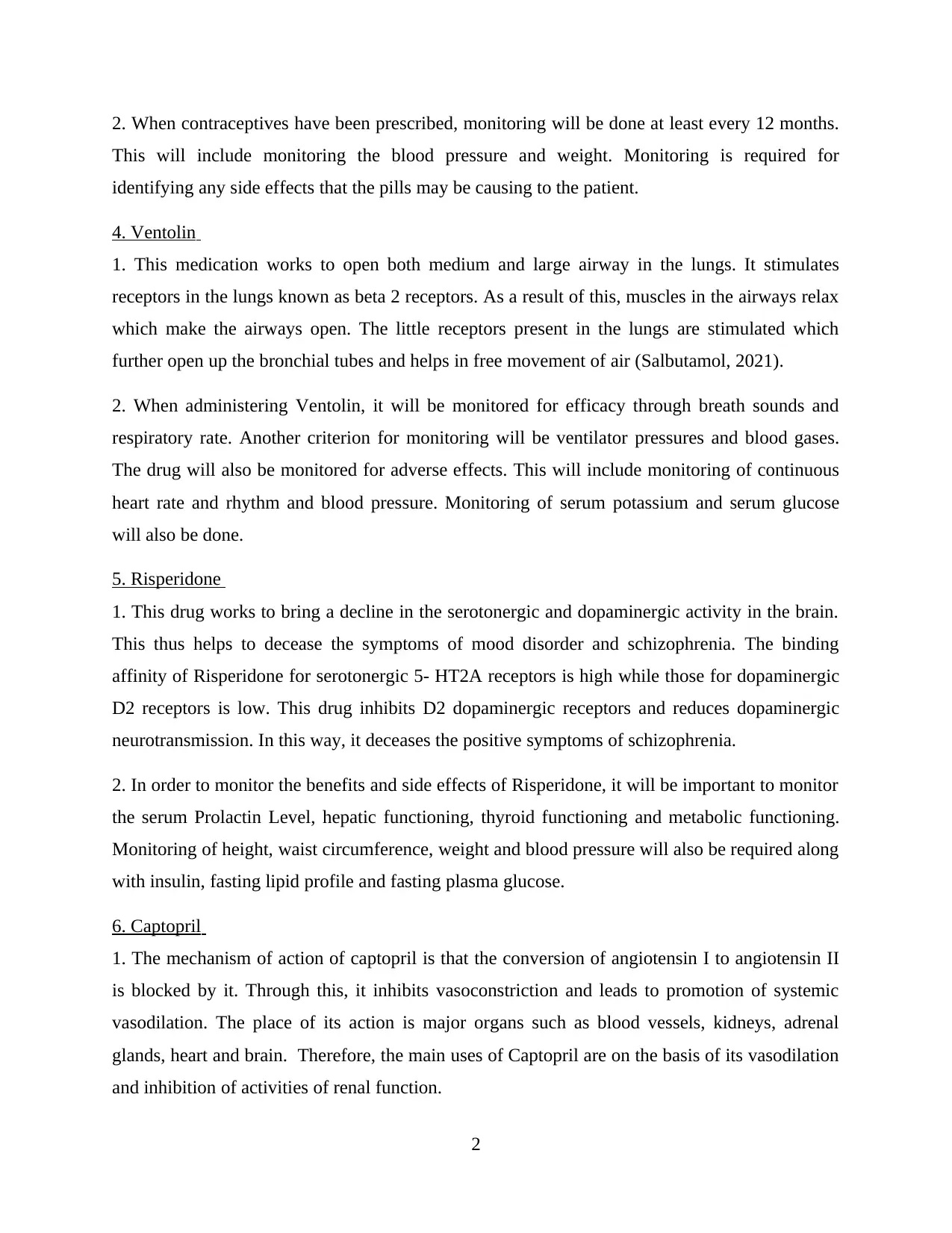
2. When contraceptives have been prescribed, monitoring will be done at least every 12 months.
This will include monitoring the blood pressure and weight. Monitoring is required for
identifying any side effects that the pills may be causing to the patient.
4. Ventolin
1. This medication works to open both medium and large airway in the lungs. It stimulates
receptors in the lungs known as beta 2 receptors. As a result of this, muscles in the airways relax
which make the airways open. The little receptors present in the lungs are stimulated which
further open up the bronchial tubes and helps in free movement of air (Salbutamol, 2021).
2. When administering Ventolin, it will be monitored for efficacy through breath sounds and
respiratory rate. Another criterion for monitoring will be ventilator pressures and blood gases.
The drug will also be monitored for adverse effects. This will include monitoring of continuous
heart rate and rhythm and blood pressure. Monitoring of serum potassium and serum glucose
will also be done.
5. Risperidone
1. This drug works to bring a decline in the serotonergic and dopaminergic activity in the brain.
This thus helps to decease the symptoms of mood disorder and schizophrenia. The binding
affinity of Risperidone for serotonergic 5- HT2A receptors is high while those for dopaminergic
D2 receptors is low. This drug inhibits D2 dopaminergic receptors and reduces dopaminergic
neurotransmission. In this way, it deceases the positive symptoms of schizophrenia.
2. In order to monitor the benefits and side effects of Risperidone, it will be important to monitor
the serum Prolactin Level, hepatic functioning, thyroid functioning and metabolic functioning.
Monitoring of height, waist circumference, weight and blood pressure will also be required along
with insulin, fasting lipid profile and fasting plasma glucose.
6. Captopril
1. The mechanism of action of captopril is that the conversion of angiotensin I to angiotensin II
is blocked by it. Through this, it inhibits vasoconstriction and leads to promotion of systemic
vasodilation. The place of its action is major organs such as blood vessels, kidneys, adrenal
glands, heart and brain. Therefore, the main uses of Captopril are on the basis of its vasodilation
and inhibition of activities of renal function.
2
This will include monitoring the blood pressure and weight. Monitoring is required for
identifying any side effects that the pills may be causing to the patient.
4. Ventolin
1. This medication works to open both medium and large airway in the lungs. It stimulates
receptors in the lungs known as beta 2 receptors. As a result of this, muscles in the airways relax
which make the airways open. The little receptors present in the lungs are stimulated which
further open up the bronchial tubes and helps in free movement of air (Salbutamol, 2021).
2. When administering Ventolin, it will be monitored for efficacy through breath sounds and
respiratory rate. Another criterion for monitoring will be ventilator pressures and blood gases.
The drug will also be monitored for adverse effects. This will include monitoring of continuous
heart rate and rhythm and blood pressure. Monitoring of serum potassium and serum glucose
will also be done.
5. Risperidone
1. This drug works to bring a decline in the serotonergic and dopaminergic activity in the brain.
This thus helps to decease the symptoms of mood disorder and schizophrenia. The binding
affinity of Risperidone for serotonergic 5- HT2A receptors is high while those for dopaminergic
D2 receptors is low. This drug inhibits D2 dopaminergic receptors and reduces dopaminergic
neurotransmission. In this way, it deceases the positive symptoms of schizophrenia.
2. In order to monitor the benefits and side effects of Risperidone, it will be important to monitor
the serum Prolactin Level, hepatic functioning, thyroid functioning and metabolic functioning.
Monitoring of height, waist circumference, weight and blood pressure will also be required along
with insulin, fasting lipid profile and fasting plasma glucose.
6. Captopril
1. The mechanism of action of captopril is that the conversion of angiotensin I to angiotensin II
is blocked by it. Through this, it inhibits vasoconstriction and leads to promotion of systemic
vasodilation. The place of its action is major organs such as blood vessels, kidneys, adrenal
glands, heart and brain. Therefore, the main uses of Captopril are on the basis of its vasodilation
and inhibition of activities of renal function.
2
Paraphrase This Document
Need a fresh take? Get an instant paraphrase of this document with our AI Paraphraser
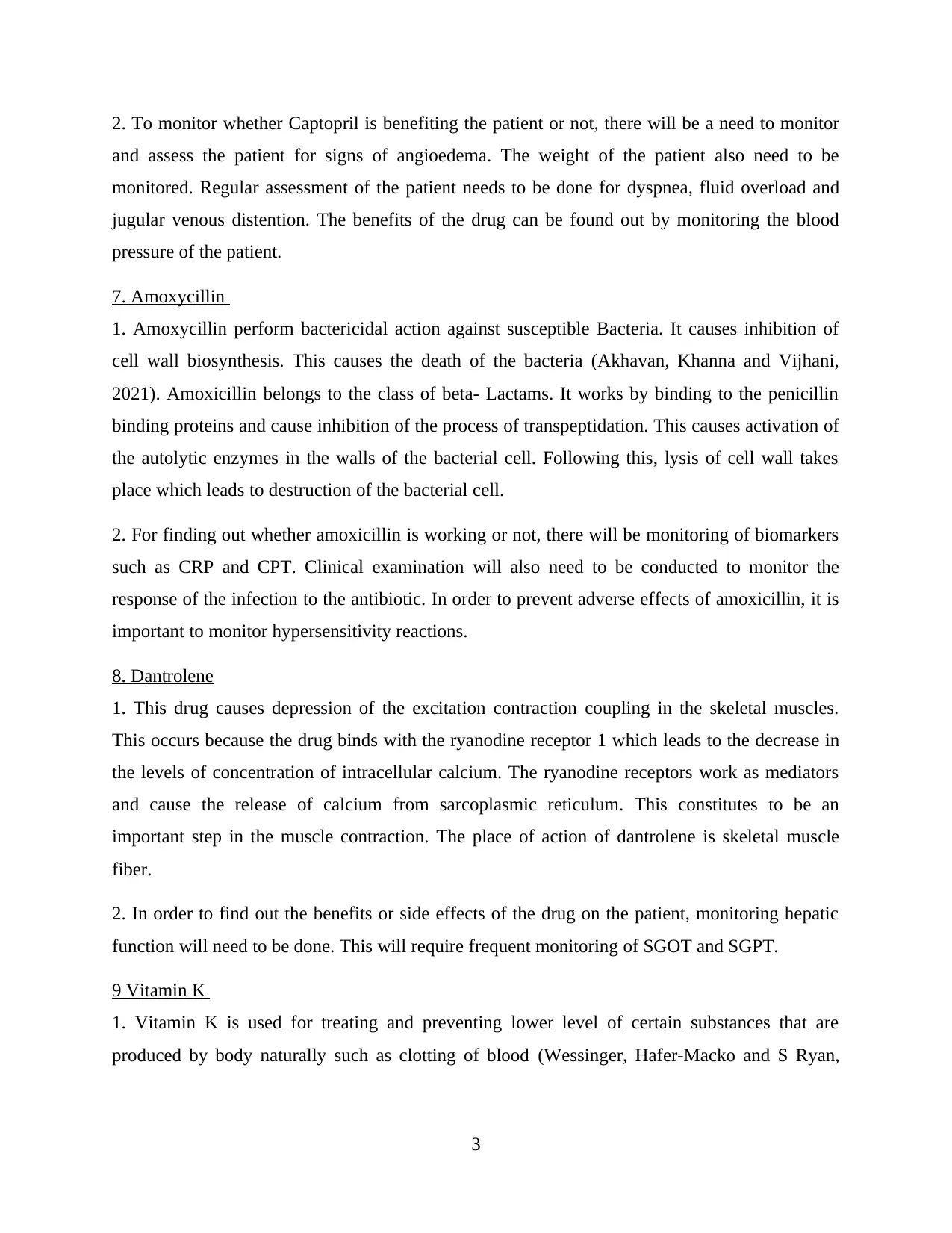
2. To monitor whether Captopril is benefiting the patient or not, there will be a need to monitor
and assess the patient for signs of angioedema. The weight of the patient also need to be
monitored. Regular assessment of the patient needs to be done for dyspnea, fluid overload and
jugular venous distention. The benefits of the drug can be found out by monitoring the blood
pressure of the patient.
7. Amoxycillin
1. Amoxycillin perform bactericidal action against susceptible Bacteria. It causes inhibition of
cell wall biosynthesis. This causes the death of the bacteria (Akhavan, Khanna and Vijhani,
2021). Amoxicillin belongs to the class of beta- Lactams. It works by binding to the penicillin
binding proteins and cause inhibition of the process of transpeptidation. This causes activation of
the autolytic enzymes in the walls of the bacterial cell. Following this, lysis of cell wall takes
place which leads to destruction of the bacterial cell.
2. For finding out whether amoxicillin is working or not, there will be monitoring of biomarkers
such as CRP and CPT. Clinical examination will also need to be conducted to monitor the
response of the infection to the antibiotic. In order to prevent adverse effects of amoxicillin, it is
important to monitor hypersensitivity reactions.
8. Dantrolene
1. This drug causes depression of the excitation contraction coupling in the skeletal muscles.
This occurs because the drug binds with the ryanodine receptor 1 which leads to the decrease in
the levels of concentration of intracellular calcium. The ryanodine receptors work as mediators
and cause the release of calcium from sarcoplasmic reticulum. This constitutes to be an
important step in the muscle contraction. The place of action of dantrolene is skeletal muscle
fiber.
2. In order to find out the benefits or side effects of the drug on the patient, monitoring hepatic
function will need to be done. This will require frequent monitoring of SGOT and SGPT.
9 Vitamin K
1. Vitamin K is used for treating and preventing lower level of certain substances that are
produced by body naturally such as clotting of blood (Wessinger, Hafer-Macko and S Ryan,
3
and assess the patient for signs of angioedema. The weight of the patient also need to be
monitored. Regular assessment of the patient needs to be done for dyspnea, fluid overload and
jugular venous distention. The benefits of the drug can be found out by monitoring the blood
pressure of the patient.
7. Amoxycillin
1. Amoxycillin perform bactericidal action against susceptible Bacteria. It causes inhibition of
cell wall biosynthesis. This causes the death of the bacteria (Akhavan, Khanna and Vijhani,
2021). Amoxicillin belongs to the class of beta- Lactams. It works by binding to the penicillin
binding proteins and cause inhibition of the process of transpeptidation. This causes activation of
the autolytic enzymes in the walls of the bacterial cell. Following this, lysis of cell wall takes
place which leads to destruction of the bacterial cell.
2. For finding out whether amoxicillin is working or not, there will be monitoring of biomarkers
such as CRP and CPT. Clinical examination will also need to be conducted to monitor the
response of the infection to the antibiotic. In order to prevent adverse effects of amoxicillin, it is
important to monitor hypersensitivity reactions.
8. Dantrolene
1. This drug causes depression of the excitation contraction coupling in the skeletal muscles.
This occurs because the drug binds with the ryanodine receptor 1 which leads to the decrease in
the levels of concentration of intracellular calcium. The ryanodine receptors work as mediators
and cause the release of calcium from sarcoplasmic reticulum. This constitutes to be an
important step in the muscle contraction. The place of action of dantrolene is skeletal muscle
fiber.
2. In order to find out the benefits or side effects of the drug on the patient, monitoring hepatic
function will need to be done. This will require frequent monitoring of SGOT and SGPT.
9 Vitamin K
1. Vitamin K is used for treating and preventing lower level of certain substances that are
produced by body naturally such as clotting of blood (Wessinger, Hafer-Macko and S Ryan,
3
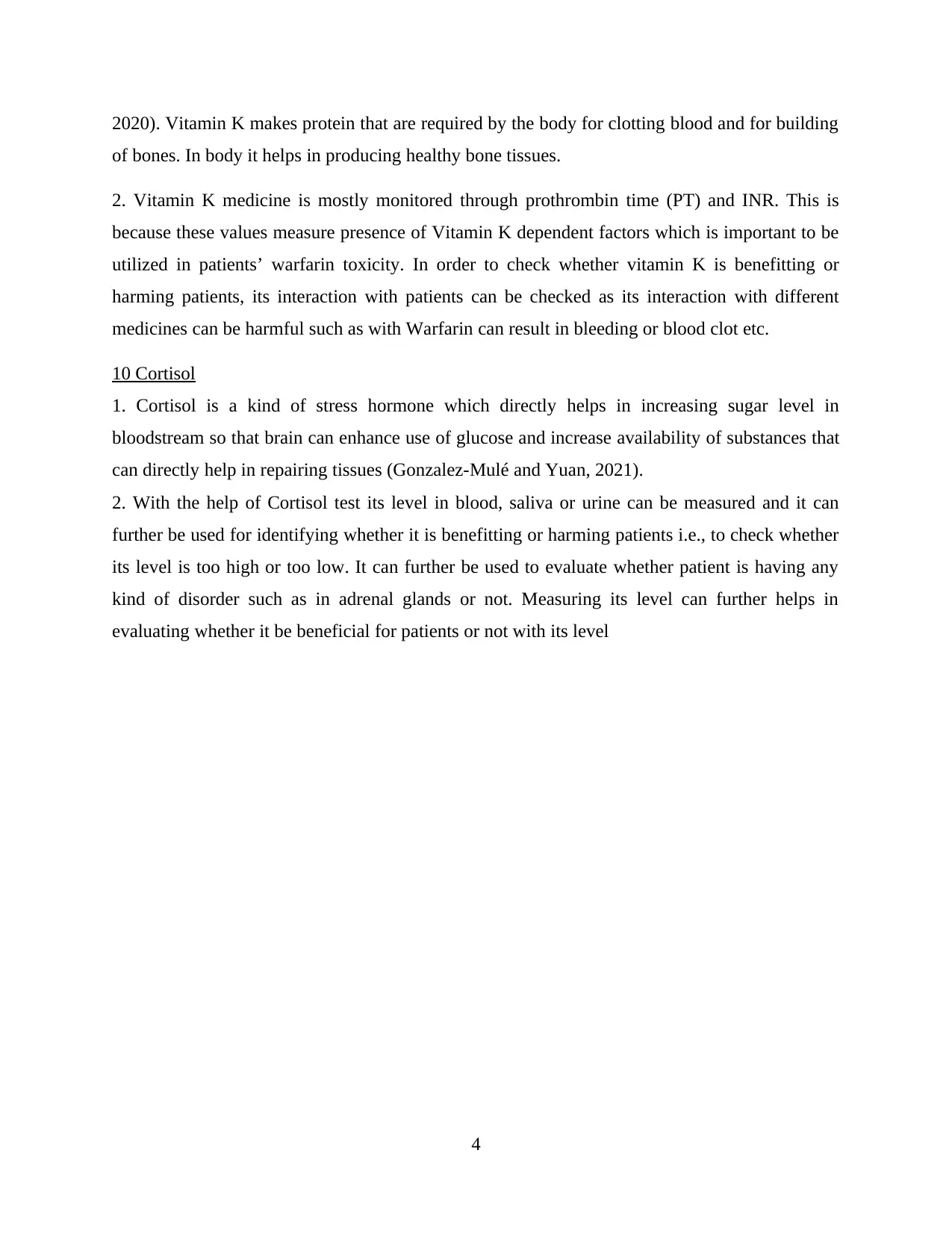
2020). Vitamin K makes protein that are required by the body for clotting blood and for building
of bones. In body it helps in producing healthy bone tissues.
2. Vitamin K medicine is mostly monitored through prothrombin time (PT) and INR. This is
because these values measure presence of Vitamin K dependent factors which is important to be
utilized in patients’ warfarin toxicity. In order to check whether vitamin K is benefitting or
harming patients, its interaction with patients can be checked as its interaction with different
medicines can be harmful such as with Warfarin can result in bleeding or blood clot etc.
10 Cortisol
1. Cortisol is a kind of stress hormone which directly helps in increasing sugar level in
bloodstream so that brain can enhance use of glucose and increase availability of substances that
can directly help in repairing tissues (Gonzalez-Mulé and Yuan, 2021).
2. With the help of Cortisol test its level in blood, saliva or urine can be measured and it can
further be used for identifying whether it is benefitting or harming patients i.e., to check whether
its level is too high or too low. It can further be used to evaluate whether patient is having any
kind of disorder such as in adrenal glands or not. Measuring its level can further helps in
evaluating whether it be beneficial for patients or not with its level
4
of bones. In body it helps in producing healthy bone tissues.
2. Vitamin K medicine is mostly monitored through prothrombin time (PT) and INR. This is
because these values measure presence of Vitamin K dependent factors which is important to be
utilized in patients’ warfarin toxicity. In order to check whether vitamin K is benefitting or
harming patients, its interaction with patients can be checked as its interaction with different
medicines can be harmful such as with Warfarin can result in bleeding or blood clot etc.
10 Cortisol
1. Cortisol is a kind of stress hormone which directly helps in increasing sugar level in
bloodstream so that brain can enhance use of glucose and increase availability of substances that
can directly help in repairing tissues (Gonzalez-Mulé and Yuan, 2021).
2. With the help of Cortisol test its level in blood, saliva or urine can be measured and it can
further be used for identifying whether it is benefitting or harming patients i.e., to check whether
its level is too high or too low. It can further be used to evaluate whether patient is having any
kind of disorder such as in adrenal glands or not. Measuring its level can further helps in
evaluating whether it be beneficial for patients or not with its level
4
⊘ This is a preview!⊘
Do you want full access?
Subscribe today to unlock all pages.

Trusted by 1+ million students worldwide
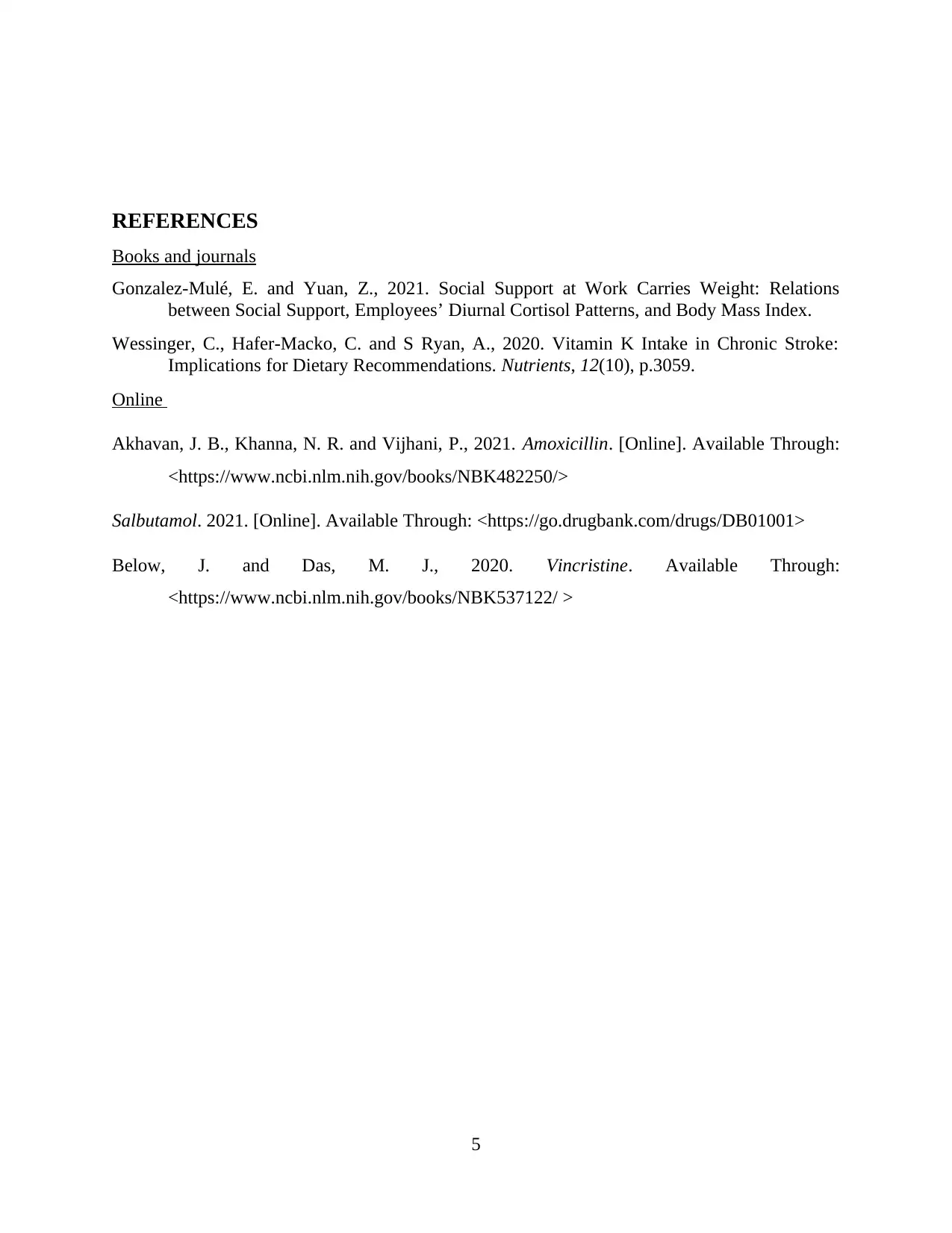
REFERENCES
Books and journals
Gonzalez-Mulé, E. and Yuan, Z., 2021. Social Support at Work Carries Weight: Relations
between Social Support, Employees’ Diurnal Cortisol Patterns, and Body Mass Index.
Wessinger, C., Hafer-Macko, C. and S Ryan, A., 2020. Vitamin K Intake in Chronic Stroke:
Implications for Dietary Recommendations. Nutrients, 12(10), p.3059.
Online
Akhavan, J. B., Khanna, N. R. and Vijhani, P., 2021. Amoxicillin. [Online]. Available Through:
<https://www.ncbi.nlm.nih.gov/books/NBK482250/>
Salbutamol. 2021. [Online]. Available Through: <https://go.drugbank.com/drugs/DB01001>
Below, J. and Das, M. J., 2020. Vincristine. Available Through:
<https://www.ncbi.nlm.nih.gov/books/NBK537122/ >
5
Books and journals
Gonzalez-Mulé, E. and Yuan, Z., 2021. Social Support at Work Carries Weight: Relations
between Social Support, Employees’ Diurnal Cortisol Patterns, and Body Mass Index.
Wessinger, C., Hafer-Macko, C. and S Ryan, A., 2020. Vitamin K Intake in Chronic Stroke:
Implications for Dietary Recommendations. Nutrients, 12(10), p.3059.
Online
Akhavan, J. B., Khanna, N. R. and Vijhani, P., 2021. Amoxicillin. [Online]. Available Through:
<https://www.ncbi.nlm.nih.gov/books/NBK482250/>
Salbutamol. 2021. [Online]. Available Through: <https://go.drugbank.com/drugs/DB01001>
Below, J. and Das, M. J., 2020. Vincristine. Available Through:
<https://www.ncbi.nlm.nih.gov/books/NBK537122/ >
5
1 out of 7
Your All-in-One AI-Powered Toolkit for Academic Success.
+13062052269
info@desklib.com
Available 24*7 on WhatsApp / Email
![[object Object]](/_next/static/media/star-bottom.7253800d.svg)
Unlock your academic potential
© 2024 | Zucol Services PVT LTD | All rights reserved.